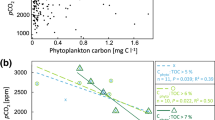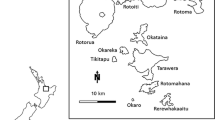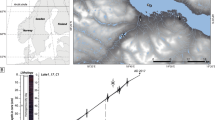Abstract
Carbon storage in lakes can have huge implications for the global carbon cycle, as lakes annually accumulate up to one half the amount of organic carbon buried in marine sediments. Yet little is known of the effect of recent climate change on carbon storage in lakes. We analyzed century-scale time series of climate variables (precipitation, temperature, NAO winter index) and profiles of sediment characteristics in a dated sediment core from shallow, eutrophic Lake Võrtsjärv, south Estonia. We used path analysis to evaluate the effect of climate conditions on phytoplankton biomass in the lake and accumulation of organic and inorganic carbon in the sediment. Changes in winter and spring climate influenced the lake’s phytoplankton growth significantly. Carbon pathways in hard-water Lake Võrtsjärv were influenced by both hydrological (most significant in colder periods) and biogeochemical processes. Increased nutrient and water input to Lake Võrtsjärv, anticipated with projected climate warming, favours greater in-lake productivity, larger accumulation of inorganic carbon in sediments, and an increase in organic carbon mineralisation, which fuels atmospheric greenhouse gas emissions from the lake.




Similar content being viewed by others
References
Adrian R, O’Reilly CM, Zagarese H, Baines SB, Hessen DO, Keller W, Livingstone DM, Sommaruga R, Straile D, Van Donk E, Weyhenmeyer GA, Winder M (2009) Lakes as sentinels of climate change. Limnol Oceanogr 54:2283–2297
Alliksaar T, Heinsalu A (2012) A radical shift from soft-water to hard-water lake: palaeolimnological evidence from Lake Kooraste Kõverjärv, southern Estonia. Est J Earth Sci 61:317–327
Appleby PG, Nolan PJ, Gifford DW, Godfrey MJ, Oldfield F, Anderson NJ, Battarbee RW (1986) 210Pb dating by low background gamma counting. Hydrobiologia 141:21–27
Arvola L, George G, Livingstone DM, Järvinen M, Blenckner T, Dokulil MT, Jennings E, Nic Aonghusa C, Nõges P, Nõges T, Weyhenmeyer GA (2010) The impact of the changing climate on the thermal characteristics of lakes. In: George G (ed) The impact of climate change on European lakes, 1st edn. Springer, Berlin, pp 85–102
BACC Author Group (2008) Assessment of climate change for the Baltic Sea basin. Springer, Berlin
Blenckner T, Adrian R, Arvola L, Järvinen M, Nõges P, Nõges T, Pettersson K, Weyhenmeyer GA (2010) The impact of climate change on lakes in northern Europe. In: George G (ed) The impact of climate change on European lakes, 1st edn. Springer, Berlin, pp 339–358
Cole JJ, Prairie YT, Caraco NF, McDowell WH, Tranvik LJ, Striegl RG, Duarte CM, Kortelainen P, Downing JA, Middelburg J, Melack JM (2007) Plumbing the global carbon cycle: integrating inland waters into the terrestrial carbon cycle. Ecosystems 10:171–184
Cremona F, Kõiv T, Nõges P, Pall P, Rõõm E-I, Feldmann T, Viik M, Nõges T (2014) Dynamic carbon budget of a large shallow lake assessed by a mass balance approach. Hydrobiologia 731:109–123
Dean WE (1999) The carbon cycle and biogeochemical dynamics in lake sediments. J Paleolimnol 21:375–393
Dean WE (2006) Characterization of organic matter in lake sediments from Minnesota and Yellowstone National Park. U.S. Geological Survey Open-File Report 2006-1053. U.S. Geological Survey, Reston, Virginia
Dean WE, Gorham E (1998) Magnitude and significance of carbon burial in lakes, reservoirs, and peatlands. Geology 26:535–538
Dearing JA, Jones RT (2003) Coupling temporal and spatial dimensions of global sediment flux through lake and marine sediment record. Glob Planet Chang 39:147–168
Downing JA, Cole JJ, Middelburg JJ, Striegl RG, Duarte CM, Kortelainen P, Prairie YT, Laube KA (2008) Sediment organic carbon burial in agriculturally eutrophic impoundments over the last century. Glob Biogeochem Cycles. doi:10.1029/2006GB002854
Eilers JM, Kann J, Cornett J, Moser K, St AmandA (2004) Paleolimnological evidence of change in a shallow, hypereutrophic lake: Upper Klamath Lake, Oregon, USA. Hydrobiologia 520:7–18
Elder JF, Rybicki NB, Carter V, Weintraub V (2000) Sources and yields of dissolved carbon in northern Wisconsin stream catchments with differing amounts of peatland. Wetlands 20:113–125
Engstrom DR, Schottler SP, Leavitt PR, Havens KE (2006) A reevaluation of the cultural eutrophication of Lake Okeechobee using multiproxy sediment records. Ecol Appl 16:1194–1206
Finlay KP, Leavitt PR, Patoine A, Wissel B (2010) Magnitudes and controls of organic carbon flux through a chain of hard-water lakes on the northern Great Plains. Limnol Oceanogr 55:1551–1564
Gälman V, Rydberg J, de-Luna SS, Bindler R, Renberg I (2008) Carbon and nitrogen loss rates during aging of lake sediment: changes over 27 years studied in varved lake sediment. Limnol Oceanogr 53:1076–1082
George DG, Maberly SC, Hewitt DP (2004) The influence of the North Atlantic Oscillation on the physical, chemical and biological characteristics of four lakes in the English Lake District. Freshw Biol 49:760–774
Grace JB (2006) Structural equation modeling and natural systems. Cambridge University Press, Cambridge
Gudasz C, Bastviken D, Steger K, Premke K, Sobek S, Tranvik LJ (2010) Temperature-controlled organic carbon mineralization in lake sediments. Nature 466:478–481
Handbook of USSR Climate (1968) Estonian SSR. Atmospheric humidity, precipitation and snow-cover, vol 4. Central Directorate of Hydrometeorological Services of Ministry of USSR, Central Directorate of Hydrometeorological Services of Estonian SSR, Tallinn Hydrometeorological Observatory. Leningrad, Gidrometeoizdat (in Russian)
Heinsalu A, Luup H, Alliksaar T, Nõges P, Nõges T (2008) Water level changes in a large shallow lake as reflected by the plankton: periphyton-ratio of sedimentary diatoms. Hydrobiologia 599:23–30
Heiri O, Lotter AF, Lemcke G (2001) Loss on ignition as a method for estimating organic and carbonate content in sediments: reproducibility and comparability of results. J Paleolimnol 25:101–110
Hodell DA, Schelske CL, Fahnenstiel GL, Robins LL (1998) Biologically induced calcite and its isotopic composition in Lake Ontario. Limnol Oceanogr 43:187–199
Hurrell JW, Kushnir Y, Visbeck M (2001) The North Atlantic oscillation. Science 291:603–605
IPCC (2013) Climate change 2013: the physical science basis. In: Stocker TF, Qin D, Plattner G-K, Tignor M, Allen SK, Boschung J, Nauels A, Xia Y, Bex V, Midgley PM (eds) Contribution of working group I to the fifth assessment report of the intergovernmental panel on climate change. Cambridge University Press, Cambridge
Jaagus J (2006) Climatic changes in Estonia during the second half of the 20th century in relationship with changes in large-scale atmospheric circulation. Theor Appl Climatol 83:77–88
Järvet A (2004) Hydrology of Lake Võrtsjärv. In: Haberman J, Pihu E, Raukas A (eds) Lake Võrtsjärv. Estonian Encyclopaedia, Tallinn, pp 105–139
Järvet A, Jaagus J, Roosaare J, Tamm T, Vallner L (2000) Impact of climate change on water balance elements in Estonia. Geogr Stud 8:35–55
Kalff J (2001) Limnology. Prentice Hall, Upper Saddle River, pp 309–348
Knutti R, Sedláček J (2013) Robustness and uncertainties in the new CMIP5 climate model projections. Nat Clim Chang 3:369–373
Koeve W (2002) Upper ocean carbon fluxes in the Atlantic Ocean: the importance of the POC:PIC ratio. Glob Biogeochem Cycles 16:4-1–4-17
Laas A, Nõges P, Kõiv T, Nõges T (2012) High-frequency metabolism study in a large and shallow temperate lake reveals seasonal switching between net autotrophy and net heterotrophy. Hydrobiologia 694:57–74
Leavitt PR, Hodgson DA (2001) Sedimentary pigments. In: Smol JP, Birks HJB, Last WM (eds) Tracking environmental change using lake sediments. Terrestrial, algal, and siliceous indicators, vol 3. Kluwer, Dordrecht, pp 295–325
Leeben A, Tõnno I, Freiberg R, Lepane V, Bonningues N, Makarõtševa N, Heinsalu A, Alliksaar T (2008) History of anthropogenically mediated eutrophication of Lake Peipsi as revealed by the stratigraphy of fossil pigments and molecular size fractions of pore-water dissolved organic matter. Hydrobiologia 599:49–58
Lu Y, Meyers PA, Eadie BJ, Robbins JA (2010) Carbon cycling in Lake Erie during cultural eutrophication over the last century inferred from the stable carbon isotope composition of sediments. J Paleolimnol 43:261–272
Lücke A, Schleser GH, Zolitschka B, Negendank JFW (2003) A Lateglacial and Holocene organic carbon isotope record of lacustrine palaeoproductivity and climatic change derived from varved lake sediments of Lake Holzmaar, Germany. Quat Sci Rev 22:569–580
Mander Ü, Kull A, Kuusemets V, Tamm T (2000) Nutrient runoff dynamics in a rural catchment: influence of land-use changes, climatic fluctuations and ecotechnological measures. Ecol Eng 14:405–417
Mooij WM, Janse JH, De Senerpont Domis LN, Hülsmann S, Ibelings BW (2007) Predicting the effect of climate change on temperate shallow lakes with the ecosystem model PCLake. Hydrobiologia 584:443–454
Moss B (2012) Cogs in the endless machine: lakes, climate change and nutrient cycles: a review. Sci Total Environ 434:130–142
Moss B, Kosten S, Meerhoff M, Battarbee RW, Jeppesen E, Mazzeo N, Havens K, Lacerot G, Liu Z, De Meester L, Paerl H, Scheffer M (2011) Allied attack: climate change and eutrophication. Inland Waters 1:101–105
Nõges T, Nõges P (2006) Indicators and criteria to assess ecological status of the large shallow temperate polymictic lakes Peipsi (Estonia/Russia) and Võrtsjärv (Estonia). Boreal Environ Res 11:67–80
Nõges P, Nõges T (2012) Võrtsjärv Lake in Estonia. In: Bengtsson L, Herschy RW, Fairbridge RW (eds) Encyclopedia of lakes and reservoirs. Springer, Netherlands, pp 850–861
Nõges P, Tuvikene L, Nõges T, Kisand A (1999) Primary production, sedimentation and resuspension in large shallow Lake Võrtsjärv. Aquat Sci 61:168–182
Nõges T, Nõges P, Laugaste R (2003) Water level as the mediator between climate change and phytoplankton composition in a large shallow temperate lake. Hydrobiologia 506–509:257–263
Nõges P, Kägu M, Nõges T (2007) Role of climate and agricultural practice in determining the matter discharge into large shallow Lake Võrtsjärv, Estonia. Hydrobiologia 581:125–134
Nõges P, Mischke U, Laugaste R, Solimini AG (2010a) Analysis of changes over 44 years in the phytoplankton of Lake Võrtsjärv (Estonia): the effect of nutrients, climate and the investigator on phytoplankton-based water quality indices. Hydrobiologia 646:33–48
Nõges P, Nõges T, Laas A (2010b) Climate-related changes of phytoplankton seasonality in large shallow Lake Võrtsjärv, Estonia. Aquat Ecosyst Health 13:154–163
Pall P, Vilbaste S, Kõiv T, Kõrs A, Käiro K, Laas A, Nõges P, Nõges T, Piirsoo K, Toomsalu L, Viik M (2011) Fluxes of carbon and nutrients through the inflows and outflow of Lake Võrtsjärv, Estonia. Est J Ecol 60:39–53
Patoine A, Leavitt PR (2006) Century-long synchrony of fossil algae in a chain of Canadian prairie lakes. Ecology 87:1710–1721
R Core Team (2013) R: a language and environment for statistical computing. R Foundation for Statistical Computing, Vienna. http://www.R-project.org/. ISBN: 3-900051-07-0
Raukas A, Tavast E (2002) The Holocene sedimentation history of Lake Võrtsjärv, central Estonia. Geol Q 46:199–206
Rose NL, Morley D, Appleby PG, Battarbee RW, Alliksaar T, Guilizzoni P, Jeppesen E, Korhola A, Punning J-M (2011) Sediment accumulation rates in European lakes since AD 1850: trends, reference conditions and exceedence. J Paleolimnol 45:447–468
Rosseel Y (2012) lavaan: an R package for structural equation modeling. J Stat Softw 48:1–36
Shipley B (2000) Cause and correlation in biology. A user’s guide to path analysis, structural equations and causal inference. Cambridge University Press, Cambridge
Sobek S, Durisch-Kaiser E, Zurbrügg R, Wongfun N, Wessels M, Pasche N, Wehrli B (2009) Organic carbon burial efficiency in lake sediments controlled by oxygen exposure time and sediment source. Limnol Oceanogr 54:2243–2254
Toming K, Tuvikene L, Vilbaste S, Agasild H, Viik M, Kisand A, Feldmann T, Martma T, Jones RI, Nõges T (2013) Contributions of autochthonous and allochthonous sources to dissolved organic matter in a large, shallow, eutrophic lake with a highly calcareous catchment. Limnol Oceanogr 58:1259–1270
Tõnno I, Kirsi A-L, Freiberg R, Alliksaar T, Lepane V, Kõiv T, Kisand A, Heinsalu A (2013) Ecosystem changes in large and shallow Võrtsjärv, a lake in Estonia—evidence from sediment pigments and phosphorus fractions. Boreal Environ Res 18:195–208
Tranvik LJ, Downing JA, Cotner JB, Loiselle SA, Striegl RG, Ballatore TJ, Dillon P, Finlay K, Fortino K, Knoll LB, Kortelainen PL, Kutser T, Larsen S, Laurion I, Leech DM, McCallister SL, McKnight DM, Melack JM, Overholt E, Porter JA, Prairie Y, Renwick WH, Roland F, Sherman BS, Schindler DW, Sobek S, Tremblay A, Vanni MJ, Verschoor AM, von Wachenfeldt E, Weyhenmeyer GA (2009) Lakes and reservoirs as regulators of carbon cycling and climate. Limnol Oceanogr 54:2298–2314
Acknowledgements
This study was funded by institutional research grants IUT21-2 and IUT1-8 from the Estonian Science Agency, by Estonian Science Foundation Grants No. ETF9031 and ETF9102 and by a Swiss Grant from the Programme “Enhancing public environmental monitoring capacities.”
Author information
Authors and Affiliations
Corresponding author
Rights and permissions
About this article
Cite this article
Ehapalu, K., Tõnno, I., Reitalu, T. et al. Sedimentary carbon forms in relation to climate and phytoplankton biomass in a large, shallow, hard-water boreal lake. J Paleolimnol 57, 81–93 (2017). https://doi.org/10.1007/s10933-016-9931-1
Received:
Accepted:
Published:
Issue Date:
DOI: https://doi.org/10.1007/s10933-016-9931-1




